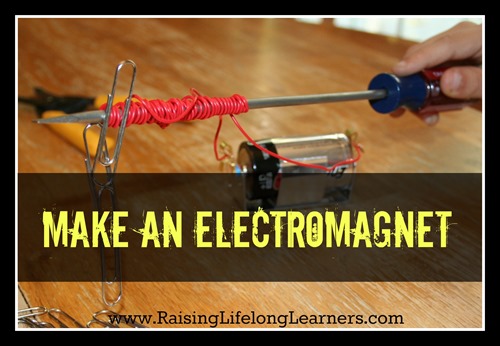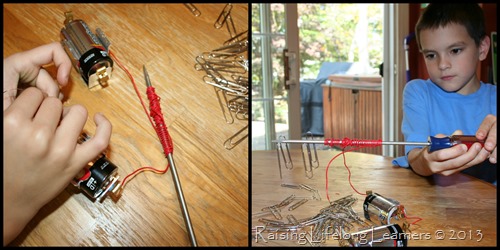Make a Simple Electromagnet
So glad you’re here! It’s been fun exploring electricity and magnetism over the last two weeks. If you’re new here, consider starting back at day one of the series and downloading or printing the activities to build a cohesive unit study for your child. Today we’re talking about electromagnets.
In 1820, Hans Christian Oersted noted that an electrical current creates a magnetic field when he moved an electrical wire near a compass and the needle jumped. Michael Faraday discovered that the reverse was true a few years later – a magnetic field could also generate electricity. The relationship between electricity and magnetism was confirmed.
Electricity and magnetism have many differences though. A magnetic field always flows into itself and cannot be separated from its poles. An electrical current, though, can flow out and back into itself. this is what makes it possible to use electricity to run toys, lamps, televisions, and other household items. Magnetism can pass through materials that electricity cannot like glass and plastic.
Electromagnets are made when an electrical current runs through a wire. The current creates a magnetic field that disappears when the electricity is turned off. In today’s activity, your child can create and experiment with an electromagnet.
You’ll need:
- a long screwdriver or nail
- coated wire
- paper clips or small metal washers
- D battery and holder
Try it this way:
- Spread the washers or paper clips on the table or desk.
- Wind your wire 10-15 {or more} times around the screwdriver.
- Attach one end of the wire to one end of the battery in its holder.
- Attach the other end of the wire to the other end of the battery.
- Pick up the screwdriver, it now has an electrical charge running through it creating a magnetic field. Run it through the pile of metal objects.
- How many things did the electromagnet pick up?
Now, let your child experiment. How can he or she make the electromagnet stronger? Would it make a difference to add more batteries? How about wrapping the coils tighter? Looser? Wrapping the wore more or fewer times around the screwdriver?
Come back tomorrow for the last day {for now} of electricity and magnetism. We’ll explore some of the uses for magnets in our world. If you haven’t already, take a moment to subscribe by email. Great things are coming in the next few months. I’d love for you to stick around for them.
I’m looking forward to wrapping up the series with you tomorrow. Have a great day, and thanks for checking us out today!





